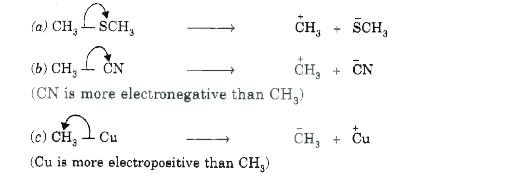Using the curved-arrow notation, show the formation of reactive intermediates when the following convalent bonds undergo heterolytic cleavage :
(a) CH3−S−CH3
(b) CH3−CN
( c) CH3−Cu .
Topper's Solved these Questions
- ORGANIC CHEMISTRY: BASIC PRINCIPLES AND TECHNIQUESBOOK - MODERN PUBLICATIONCHAPTER - ORGANIC CHEMISTRY: BASIC PRINCIPLES AND TECHNIQUESEXERCISE - (PRACTICE PROBLEMS)
31 Videos
- ORGANIC CHEMISTRY: BASIC PRINCIPLES AND TECHNIQUESBOOK - MODERN PUBLICATIONCHAPTER - ORGANIC CHEMISTRY: BASIC PRINCIPLES AND TECHNIQUESEXERCISE - (CONCEPTUAL QUESTIONS 1 )
29 Videos
- MOCK TEST-2BOOK - MODERN PUBLICATIONCHAPTER - MOCK TEST-2EXERCISE - SECTION D
1 Videos
- REDOX REACTIONS BOOK - MODERN PUBLICATIONCHAPTER - REDOX REACTIONS EXERCISE - COMPETITION FILE (Objective Questions) (C. MULTIPLE CHOICE QUESTIONS)
9 Videos
Similar Questions
Using the curved-arrow notation, show the formation of reactive intermediates when the following convalent bonds undergo heterolytic cleavage :
(a) CH3−S−CH3
(b) CH3−CN
( c) CH3−Cu .
View SolutionUsing curved arrows rotation,show the formation of reactive intermediates when the following covalent bonds undergo heterolytic fission.
(a) CH3−CN
(b) CH3−Cu
View Solution
Knowledge Check
In CH3CH2OH, the bond that undergoes heterolytic cleavage most readily is
AC−CBC−OCO−HDC−HIn CH3CH2OH the bond that undergoes heterolytic cleavage most readily is:
AC−CBC−OCC−HDO−HIn CH3CH2OH, the bond that undergoes heterolytic cleavage most readily is
AC-CBC-OCC-HDO-H
Using curved arrow notation show the formation of reaction intermediates when the following covalent bonds undergo heterolysis.
(i) H3C−CH2−Cl (ii) H3C−C≡N (iii) CH3ONa
View SolutionUsing curved-arrow notation, show the formation of reactive intermediates when convalent bonds in the following substance undergo heterolytic (polar) cleavage.
(i) CH3−SCH3 , (ii) CH3−CN
(iv) CH3−Cu , (iv) Ag−I
(v) H3N+−BF3 , (vi) Cu(−OH2)2+4
Stratergy: Both bonding electrons remain with the more electronegative atom. If the bonding atom have same electronegetivities,, then the bonding electrons are taken away by the larger atom as it can sustain the negative charge more effectively.
View SolutionIdentify electrophilic centre in the following :
(1) CH3CH=O
(2) CH3−CN
(3) CH3I.
View SolutionIn CH3CH2OH, the bond that undergoes heterolytic cleavage most readily is
View SolutionIn CH3CH2OH, the bond that undergoes heterolytic cleavage most readily is:
View Solution

